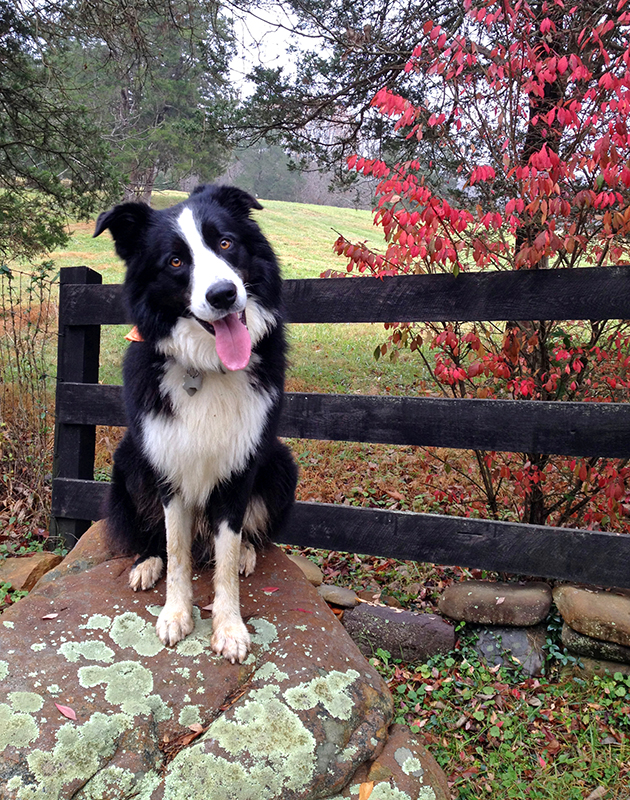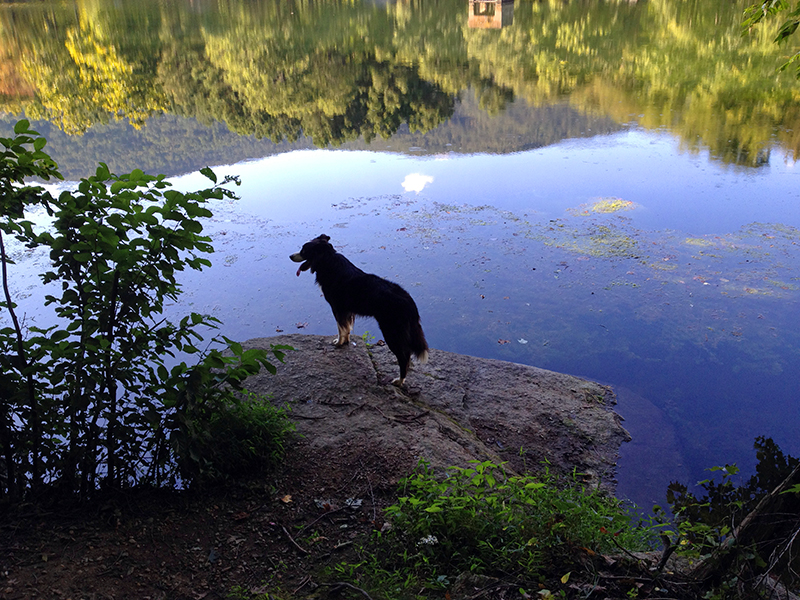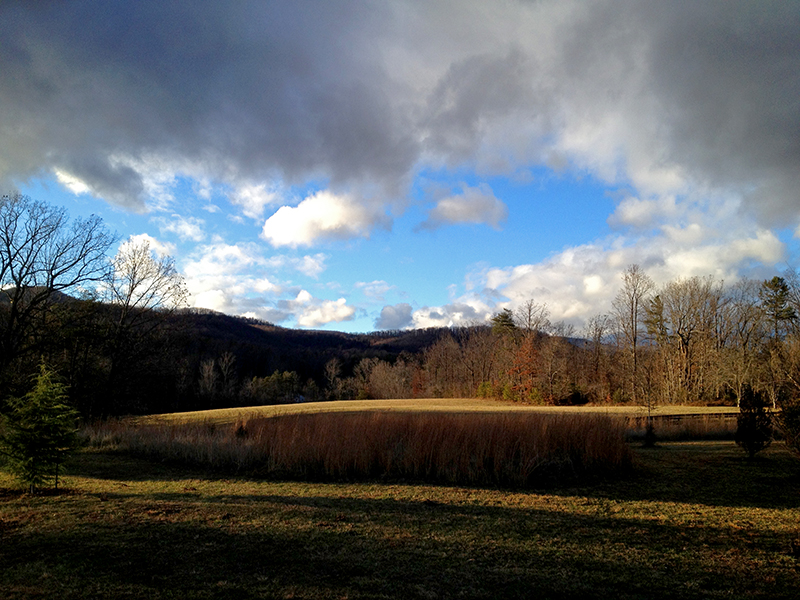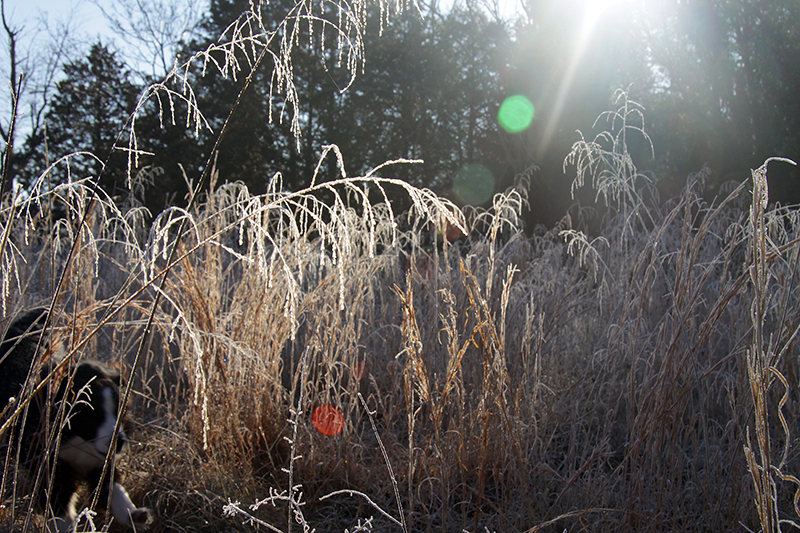January 19th, 2014 §
“Gardening” is a bit of a stretch for what I did today as I walked the property, but it’s all I can do. With everything cold and sleeping, today’s tasks included checking staked trees for girdling and rodent attacks. I scraped a liquified but frozen dead mouse (mousesicle?) out of the crawlspace entry, and pruned still-more cicada damage out of the dogwoods. Most of my time was spent shoveling and sweeping the house garden’s mulch and compost back into place. The chickens are doing their winter thing, which is scratching in the loosest, most fertile and worm-filled soil of the acres they have access to—which happens to be in my garden. Of course. All this chicken activity exposes the prenatal tips of spring flowering bulbs, all pale and startled-looking to be so untimely unearthed.

So I go around and cover these little tips with compost and try to move and pat everything into place with reassurances: “Not quite yet, naked ladies, hold tight for a few more months and if any of those chickens take a nip, bite back.” Even as I tuck these shoots away it’s hard to contain my excitement that something’s happening under the dirt. Those promises sowed in November are halfway toward realization.
I’m itching to take the pruners to some of the standing dead perennial foliage that’s dragging the ground, but I learned my lesson last year when I lost track of where I’d planted certain things and smothered them under a new mulch application. So the stragglers stand, marking the location of my plants at least until I get the spring mulch down. I’m trying to view these dried-out sticks and seed heads through the naturalistic lens of some of my favorite garden designers, who design entire landscapes to be appreciated just like this in winter.
The best-looking thing in the garden right now is almost microscopic: my sedum. Sedum “Angelina” has taken on fantastic rainbow colors, and some unnamed small pink sedum is positively fluorescent.
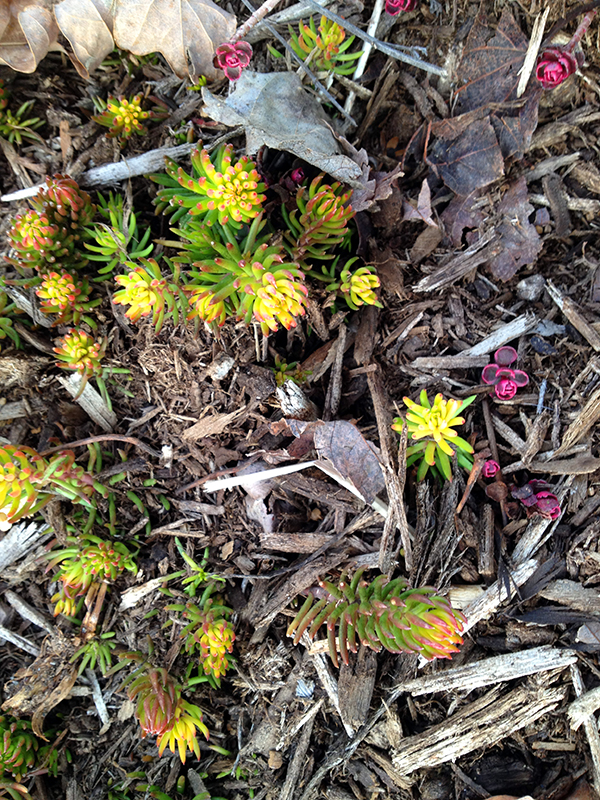
It looks like the polar vortex of a couple weeks ago has already claimed some casualties. My Distylium “Blue Cascade,” which is being heavily marketed as an evergreen landscaping shrub suitable for zones 6b-9, is showing an aesthetically distressing but intellectually interesting pattern of winter burn that wasn’t there before we had our flirtation with zero degrees.
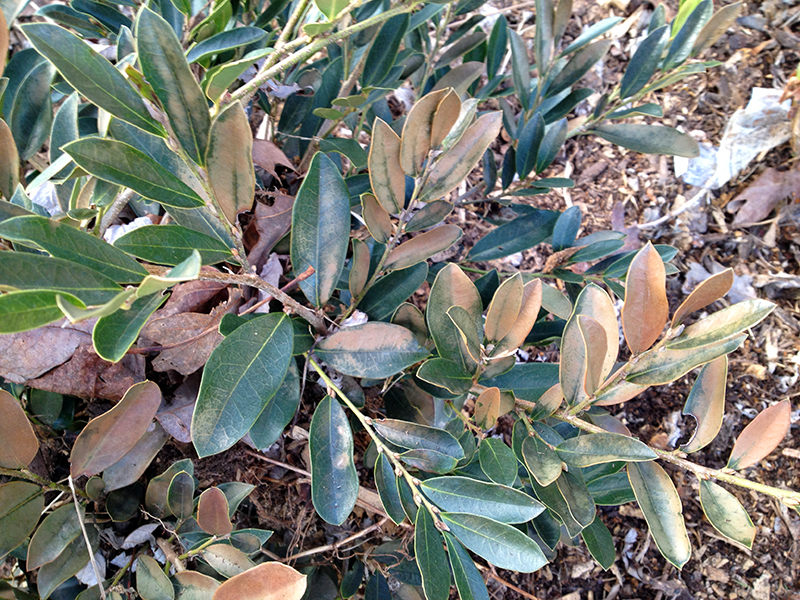
It will be interesting to see how it recovers—good thing I stuck just two of these shrubs in to trial instead of relying on them to carry an entire foundation planting.
And one of my two large clumps of rosemary decided that zero degrees just isn’t a Mediterranean climate, and it’s begun to brown out in a serious way.
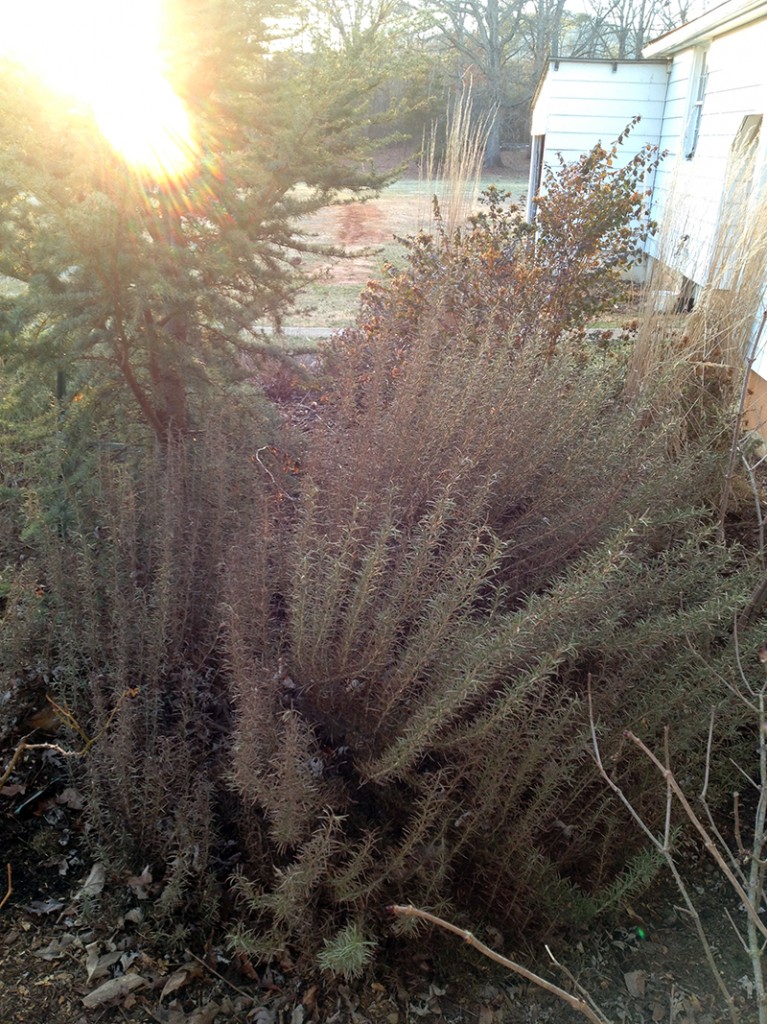
I admit that this big clump, which began as three smaller plants, wasn’t in peak form heading into winter. It had some sort of mite infestation that, while it wasn’t killing it, wasn’t exactly helping things. The interesting thing is that the other rosemary grouping, less than 20 feet away on the other side of the front walk with a similar exposure, evaded both the mite problem and the damaging effects of the polar vortex. Just like humans, plants with healthy immune systems are better able to withstand environmental stressors.
Is it sick to be excited to rip out the rosemary and have a nice big section to fill with something new? I didn’t ever plan for rosemary to become a foundation planting for me—I wasn’t expecting it to be winter hardy here—but it was (for a while!) and once it got big and took up space and stayed greenish through winter, I let it live. But now that it’s brownish, I have no compunction about pulling it all out come spring. As I’ve said before, I like taking things out of the garden more than I like putting things in. It’s a great feeling to give myself permission to correct course midstream, experiment, modify and adapt, and put new knowledge into practice through good editing.
January 17th, 2014 §
January 13th, 2014 §
It’s cold, dark and raining—you know, typical winter—and I’m seriously missing hours spent in the garden, not to mention the antidepressant effect of playing in the dirt. I really liked writing about the High Line a few weeks ago, and it made me realize that I have untold stories of other equally wonderful gardens. Because of that, and because nobody wants to read a post on how I’ve spent the last two days regrouting my shower, let’s get out of here and find something pretty with a short series on some of my favorite gardens that I’ve visited in the past few years.
First we’ll go to England and visit Bourton House, right in the beautiful Cotswold countryside near Morteon-in-Marsh. I stayed in this area for a couple of weeks in July, 2012, and took these photos then.
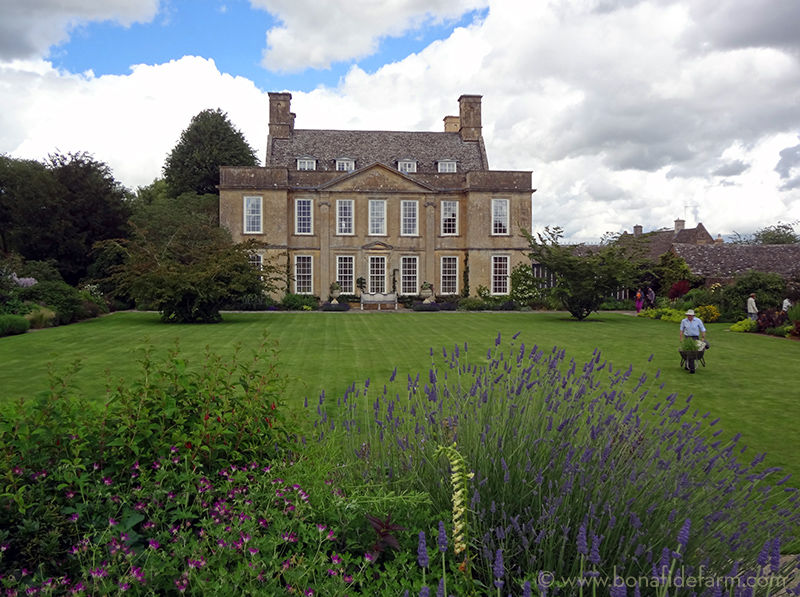
A bit of history from the Bourton House Web site:
Built on monastic lands, Bourton House and its Brewhouse, Stables and Coach House have created a courtyard since the late 16th century.
The house itself was rebuilt as a foursquare Jacobean house by the eminent lawyer, Sir Nicholas Overbury in 1598. At the beginning of the 18th century, the then unfashionable house was once again rebuilt on the earlier footprint by Alexander Popham, the grandson of a Cromwellian general. The house was taken down to its lower ground floor but the whimsical towers retained, the slits replaced by generous Georgian sash windows. The architect remains unknown. This setting has remained unchanged for three hundred years.
The lands originally belonging to the manor were sold in 1851 by Sir James Buller East MP, to the neighbouring Sezincote estate. Today Bourton House is surrounded by its immediate three-acre garden and a seven acre walled pasture, now given over to specimen trees and sculpture.
In 1953 the house and land were sold at auction and there followed a quick succession of owners, six to be exact, until 1983 when the house was acquired by Richard and Monique Paice.

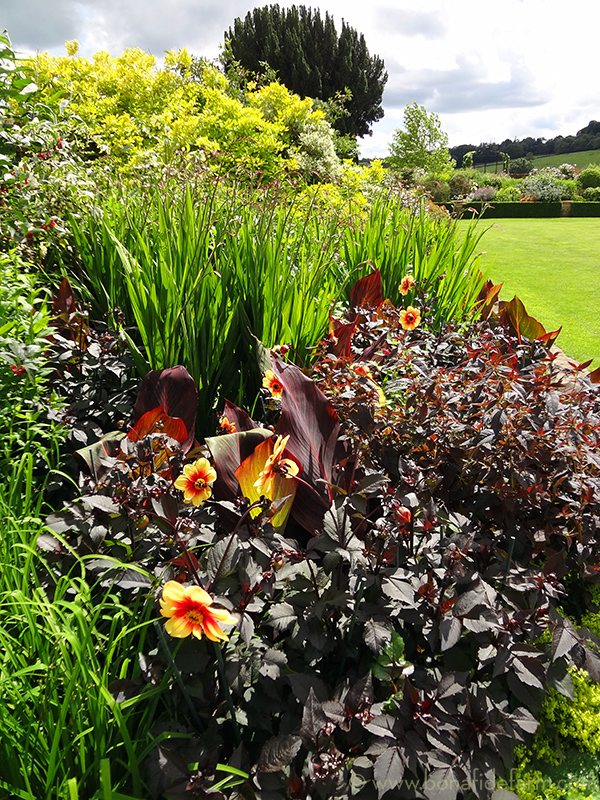
The ornamental garden with its 18th century raised walk overlooking the rolling Cotswold hills; the original kitchen garden and orchard have been transformed in the past twenty five years. This achievement was recognised when Bourton House Garden received the prestigious HHA/Christie’s GARDEN OF THE YEAR (2006) award.
In 2010, the house was sold. The new owners have decided to keep the Garden open to the public with the active help of Head Gardener Paul Nicholls and Assistant Gardener Jacky Rae. Paul and Jacky have been responsible over many years for turning vision into reality and creating the wonderful garden seen today.
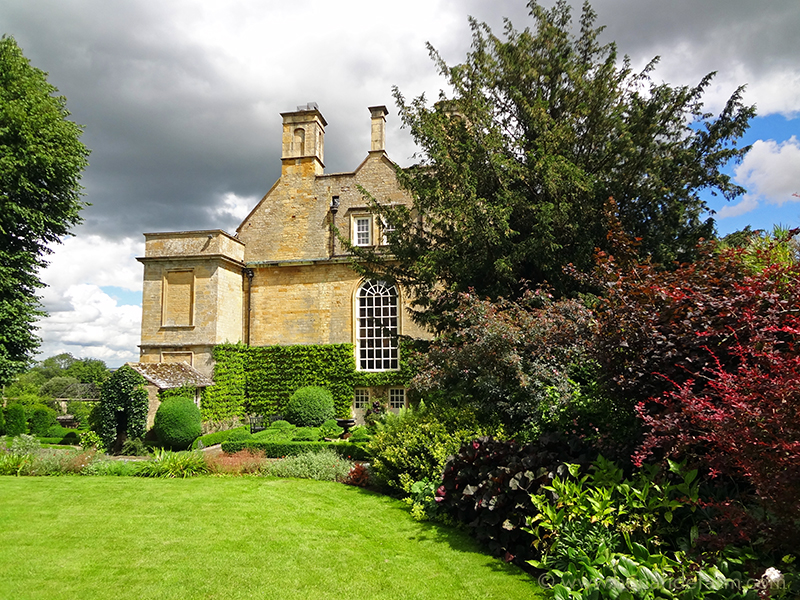
I was really impressed by the use of contrast in the Bourton House garden. As you can see in the two photos above, plants with dark foliage (dahlia and canna up above, and barberry and some other now-unidentifiable things below) are used to break up the swaths of pure green plants and grass. The dark plants create the effect of shadow even in full-sun exposures, and increase the visual depth of the borders.
The estate is surrounded by pastures filled with sheep and cows. It was lovely to hear their soft grazing noises while walking the grounds, and they’re very pretty lawn ornaments! Although I know firsthand that the day-to-day caretaking of livestock can often be the very opposite of bucolic, it was nice to dream a bit and aesthetically appreciate these animals without having to worry about their care.
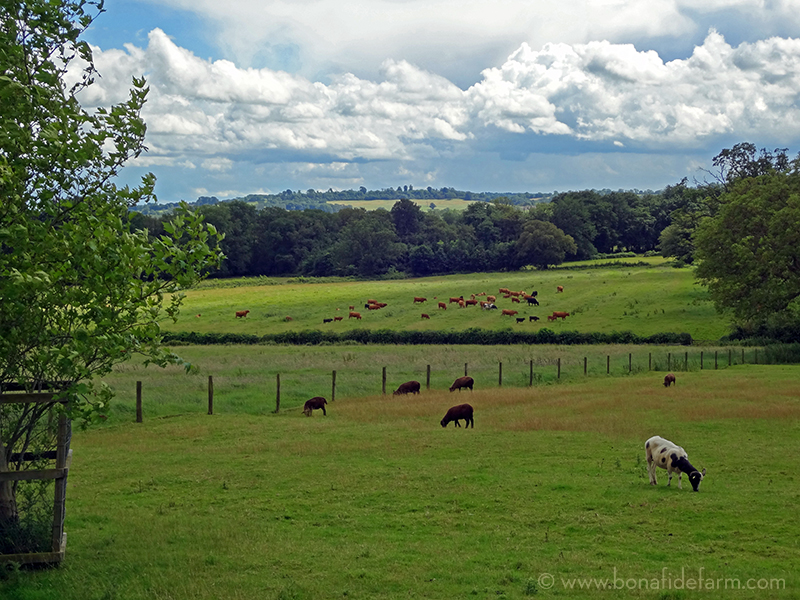
I was impressed by how dynamic the clouds, sky and weather were in England during my visit. You can see in this series of photos, taken in just a couple hours, that the sun moved in and out from behind the clouds. Rain came and went as showers passed by. This made photographing fun and challenging, and the skies were never boring. It also made everything green, green, green! Just looking at these photos is already helping to alleviate my winter doldrums!
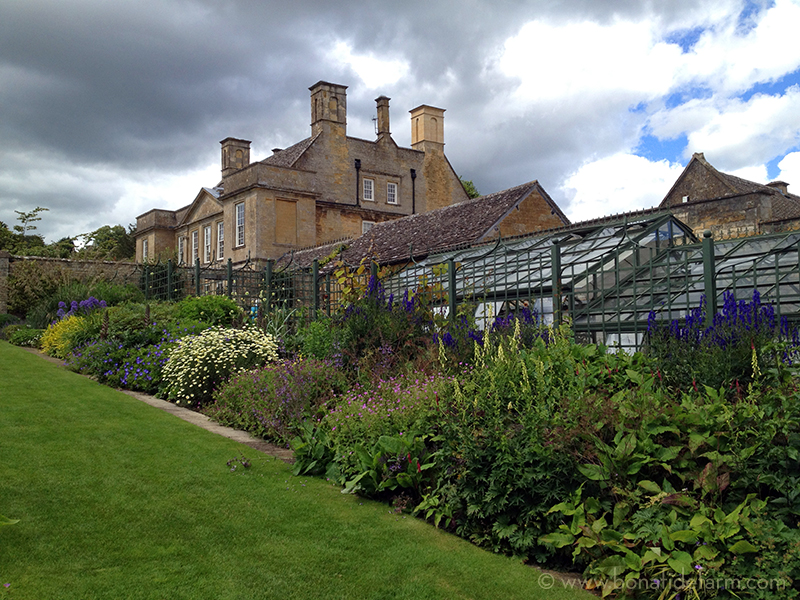
The beautiful glass house wasn’t full as it was high summer in England when I visited, but I can imagine how wonderful that space would be when used to start seedlings and extend the season into fall. Cold frames, below, are built up against the foundation of the glass house and are open to the sun. I love how the more modern glass house is incorporated into the ancient compound without it feeling intrusive or out of place. It’s a good lesson in proper scale and the wonderfully camouflaging properties of dark green paint.
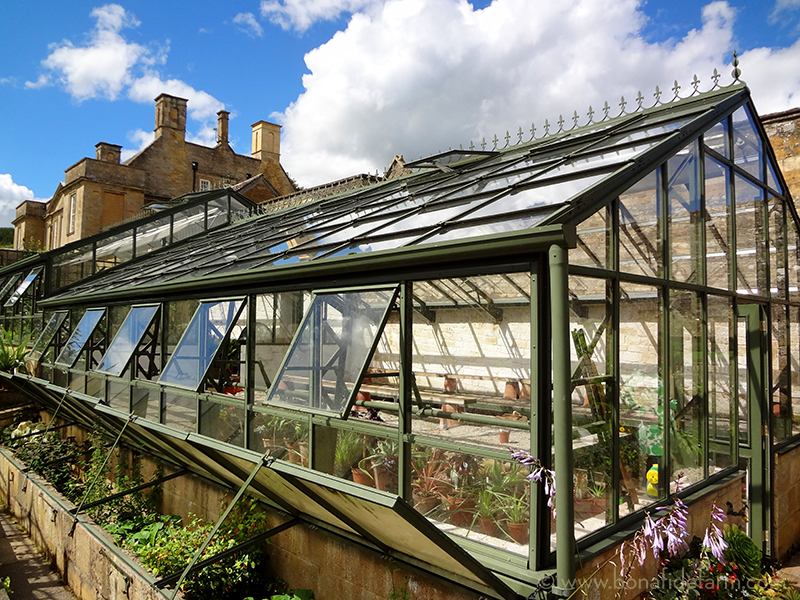
Up next: We examine the Bourton House garden in closer detail, and step inside a gorgeous 16th century tithe barn.
January 7th, 2014 §
Life in this already-small house has contracted to a few cozy square feet right in front of the wood stove as we wait for temperatures to warm. The gang’s all here, basking in the radiant glow of the beautiful Jotul.
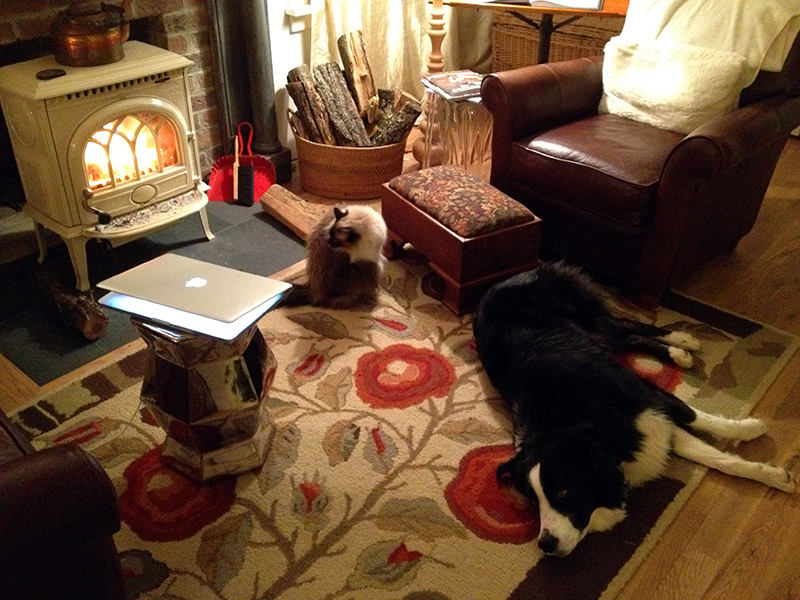
I shut off my heat pump last night to keep the expensive emergency electric heat from engaging, so we’re running on all-wood stove heat here. Keeping the stove going between 400 and 500 degrees today, and closing off the office and living room, has kept the temperature inside, in the main living area, at 65, which is the temperature I usually set the electric heat to during the day. I got up twice last night to feed the stove, and though it had burned down to large embers when I finally got up for good this morning, the house temperature had dropped to only 59 degrees in the main area. Even having no heat at all upstairs, the temperature on that floor is down to only 61. All perfectly acceptable temperatures for burning just a few armfuls of wood during the polar vortex, when, at 3:30 early this morning it was 2 degrees on my thermometer outside the kitchen window. In all I am again so pleased with my Jotul—one of my favorite, most functional, things in the world.
In times like these I really appreciate the compact layout of my house, with kitchen, wood stove, and a bathroom all within a few feet of each other. Everything I need is right here. It’s very easy to shut the doors to the guest bedroom, office and living room to contain the heat right in this area and funnel a bit of it up the stairs to the second floor. It’s actually a super-efficient design that, although I didn’t plan it to be, functions just beautifully in extreme weather events and power outages.
The chickens were fine last night. Even with their heat bulb on their gallon waterer froze solid. Once I had that defrosted they had “tea” this morning—warm water—at least until it freezes again! I’m leaving their heat light on tonight but after that temperatures will rebound and it’s back to normal winter and an unheated coop.
January 7th, 2014 §
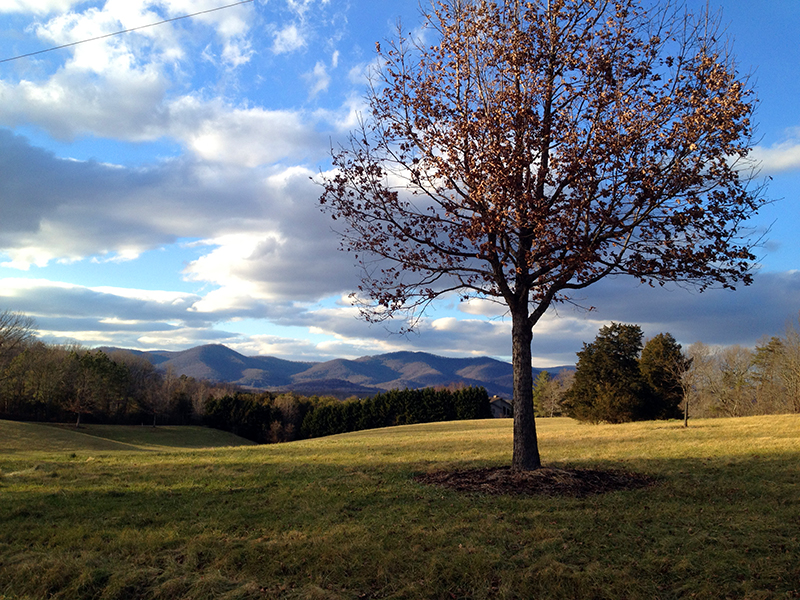
The polar vortex arrived last night and brought with it sharply clear air that made the winter light even more intense than usual.
Speaking of light, the days are noticeably lengthening. It was still light enough to see the mountains’ silhouettes when I drove home at 6:00 p.m. Hooray!
January 6th, 2014 §
What a wonderfully evocative/apocalyptic name for this weather phenomenon affecting much of the U.S.! Central Virginia is being swirled into its embrace as I write. The temperature dropped 16 degrees in the last three hours, and the thermometer outside my kitchen window now reads 10 degrees at only 9:00 p.m.
This evening I turned on a red heat bulb in the chicken coop. As long as they have access to unfrozen water and plenty of food, chickens are just fine in low temperatures without supplemental heat—they snuggle close together on the roost and they are, after all, walking around wrapped in feather duvets. But with projected temperatures near zero with a wind chill warning, tonight I figured I would help them out a little bit by closing up their windows and heating their coop. It’s very rare that I use heat in the coop—in my climate it’s really not necessary.
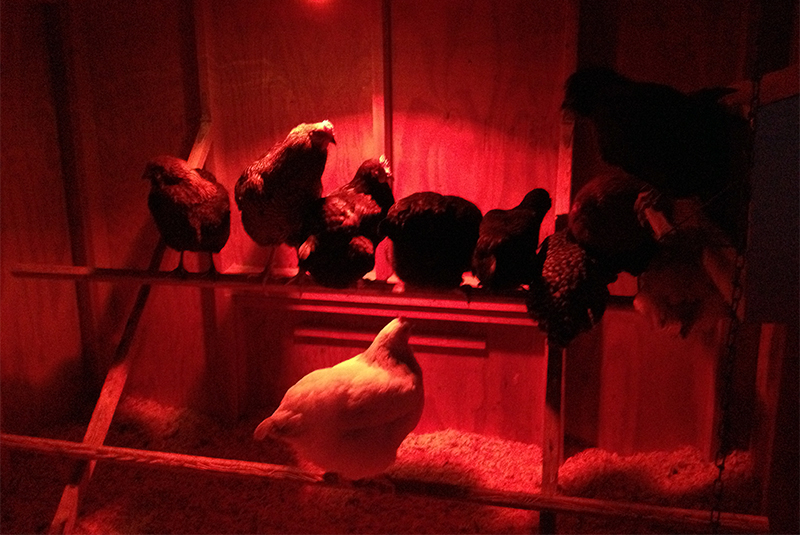
If you’re considering heating a chicken coop with a light bulb, make sure the fixture is securely installed and not just precariously hanging. The risk of fire is too high otherwise. One of my friends burned down his garage when a light fixture he’d suspended over a broody box of chicks fell into their bedding. Imagine just how fast a wooden coop filled with pine shavings would go up in smoke should a lit heat bulb fall into the bedding. That would be one hell of a rotisserie!
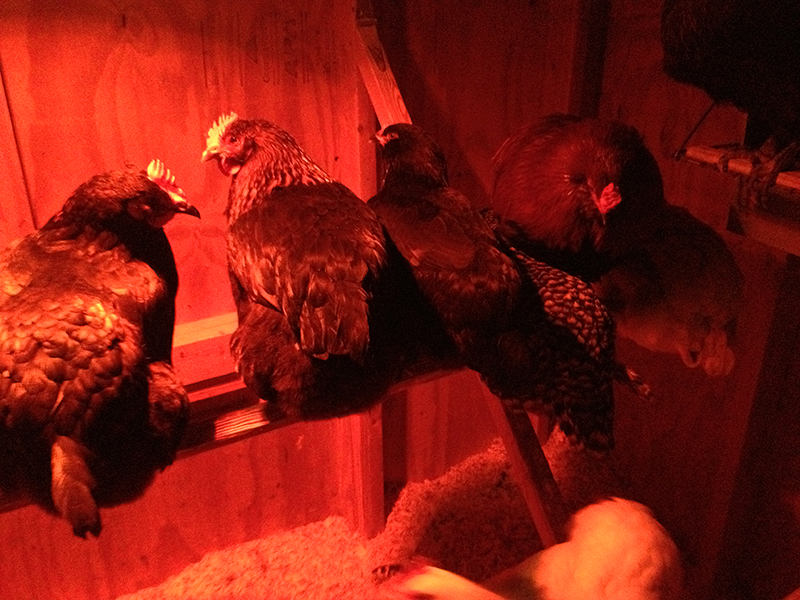
I nailed my light fixture to a rafter and used cable clips to secure the extension cord that powers it to the walls, safe from being pulled down by either people and chickens. The set-up has worked great thus far, and even though I rarely use light or heat in the coop, it’s wonderful to have it there for these polar vortex situations! Which, by the way, and despite the howling winds, I am loving (from the warm coziness of my woodstove-heated snug little home). I have high hopes that all the ticks, squash bugs, harlequin bugs, bean beetles, etc. that plague my person, pets and garden will be totally obliterated in the next two days. A girl can dream!
December 31st, 2013 §
I was driving home last night around 9:40 after a late yoga class and grocery shopping. I was almost to the village of Free Union when I saw a white beast in my headlights, in the middle of the road. At first I thought it was a coyote, and then a wolf! But as I slowed down I saw it was a dog, a little tan and white Border Collie, so scared that it was running completely hunched into a comma shape with its tail way between its legs.
I ditched the car in the nearest driveway, which happened to be a church, and opened the door. I called to the dog, but it kept skittering down the road. I saw a collar on its neck. I called it again, using all of Patricia McConnell’s tricks to get a dog to come, bending low, making myself smaller and turning my body away so as to be less threatening, and softly clapping. The dog stopped running and turned to look at me kneeling in the middle of Free Union Road. It let me approach, and both of us had a moment of faith as I reached a hand out for it to smell, it wondering if I was a friend and me wondering if I was going to get bitten.
The dog didn’t bite me, and it let me gently take hold of its collar. In my flashlight’s beam I found a tag and learned her name was Lola. Once I spoke her name her posture instantly changed, and she let me lead her over to my car where, when I opened the door, she quickly jumped in the back seat without any extra encouragement. I was glad to see she appeared uninjured.
With Lola safe in the car I called the number on her tag. A woman answered, and she was actually speechless when I introduced myself and told her I had her dog in my car. When she regained her faculties, the woman explained that she lived in Charlottesville but was actually traveling in South Carolina. She had left Lola with her mother, who lived on the road right behind my house. The woman was so flustered that I told her I would take Lola up the road with me and call her mother to come pick her up. She agreed, and we got back on the road, Lola sitting so prettily on the back seat, looking out the window. In the dark I could hear her licking her lips, so I knew she was still nervous. But she was totally polite as we wound up the road, a sweet, beautiful, obviously smart dog that reminded me a lot of my own Tucker in her energy and spirit.
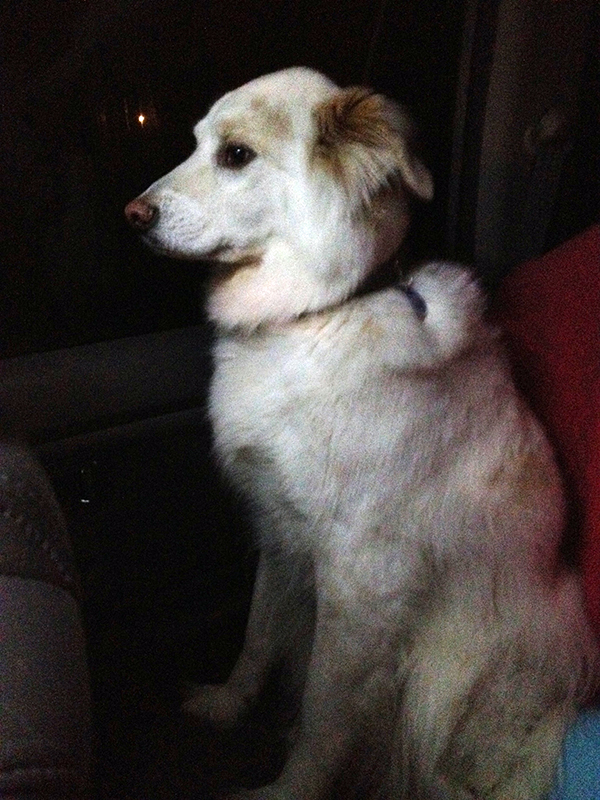
Once home I left Lola in the car for safekeeping while I got her petsitter on the phone. Within a few minutes a nice man arrived in a pickup to claim Lola. Apparently she had bolted several hours earlier, and her caretakers had been frantic looking for her before having to call their daughter to explain they’d lost her dog.
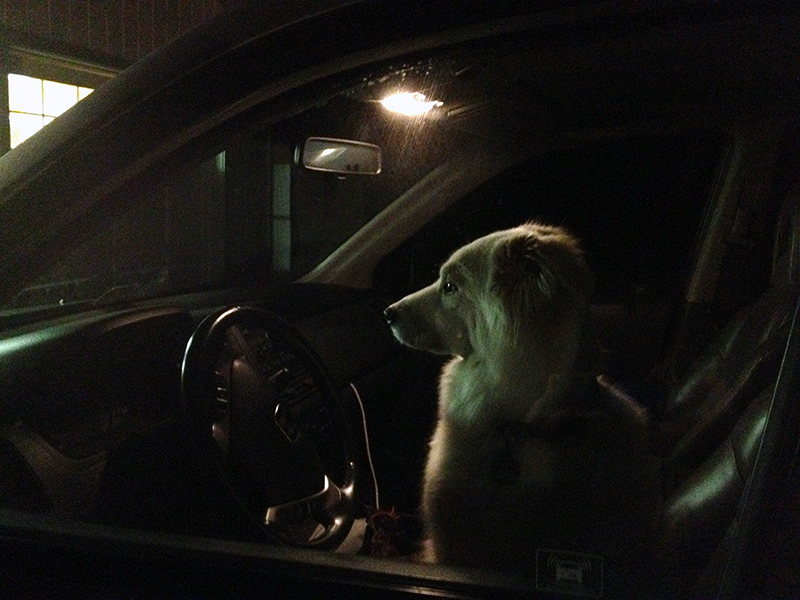
They think she was trying to get home, back to town. The man who picked her up explained that Lola was a pampered city dog, and he feared that between cars and coyotes she wouldn’t have made it long on her own. But it made me wonder—Lola had navigated five miles down three different pitch-black roads and was nine miles from home—on the right road, headed the right way—before I picked her up. It makes the movie Homeward Bound sound not entirely unreasonable.
It was after 10:00 p.m. when Lola’s owner called back to thank me again, telling me she was still so shocked. She said Lola was “like her baby” and she would have been devastated had something happened to her. I told her not to worry, that everything is okay, and to have a Happy New Year.
And with this, my dear readers, the last story of 2013, I wish you all a Happy New Year. May we all be lucky enough that adventure, heartbreak, and salvation rejoin us on the other side of midnight.
December 29th, 2013 §
December 26th, 2013 §
Last week I took the train up to Connecticut to visit a friend and caught this view approaching Manhattan. I like how this photo plays with scale, the skyscrapers of lower Manhattan dwarfed by the towers in the forefront, and all of it seemingly floating on a frozen marsh. Nature below, manmade above. You can see the Freedom Tower catching the sunset. I think the design is simple but very elegant, and I really like how the light plays on its different sides.
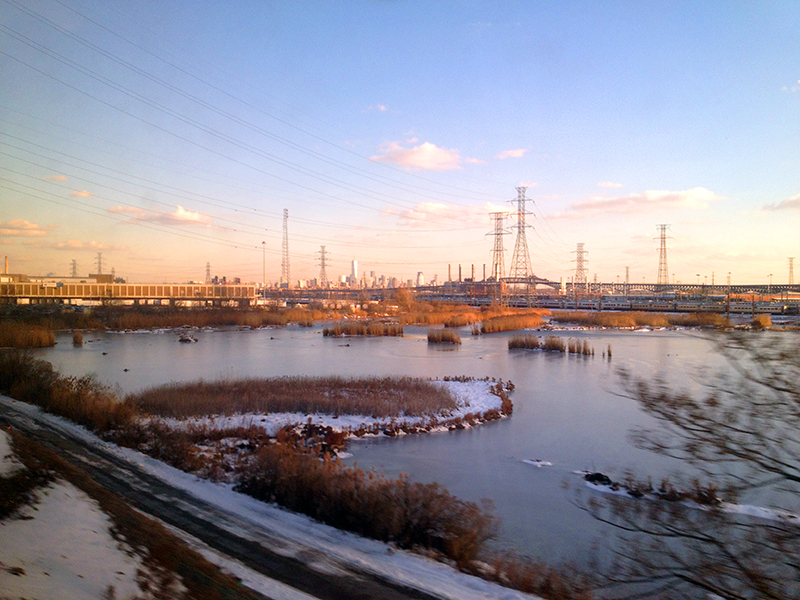
From Connecticut, we took the train into Manhattan for a day and our first destination was the High Line, a public park and garden with planting design done by my favorite garden designer, the Dutchman Piet Oudolf. The High Line used to be an abandoned, overgrown elevated railway until the Friends of the High Line got together in 1999 and garnered enough public support for the park that in 2004 New York City granted $50 million for the project.
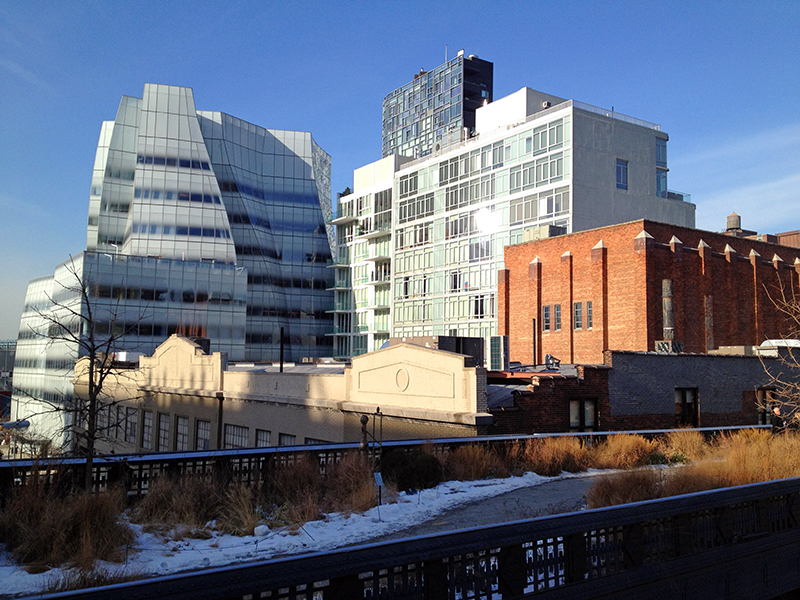
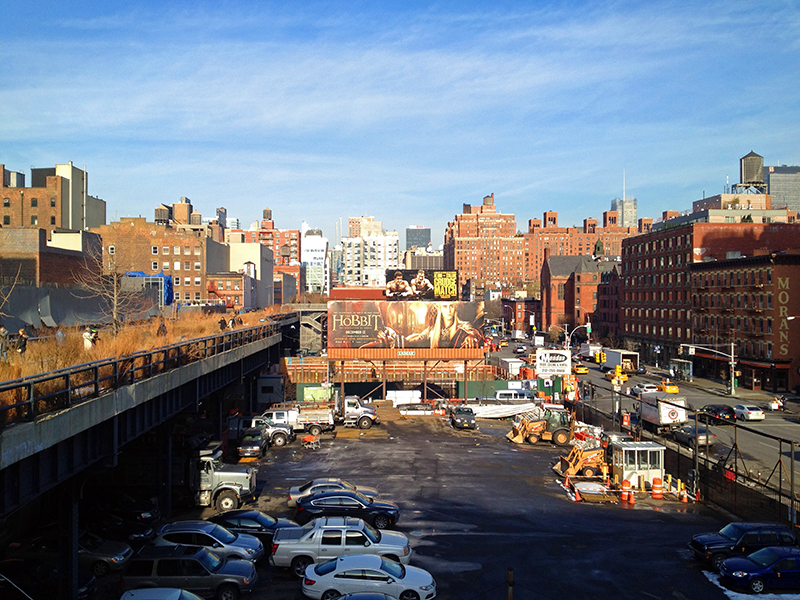
The park has been completed in sections since then, and it’s achieved worldwide recognition for its success at transforming urban blight into public greenspace, and revitalizing a formerly decrepit area of the city. Chicago, Philadelphia and St. Louis are studying the High Line as a potential model for their cities.
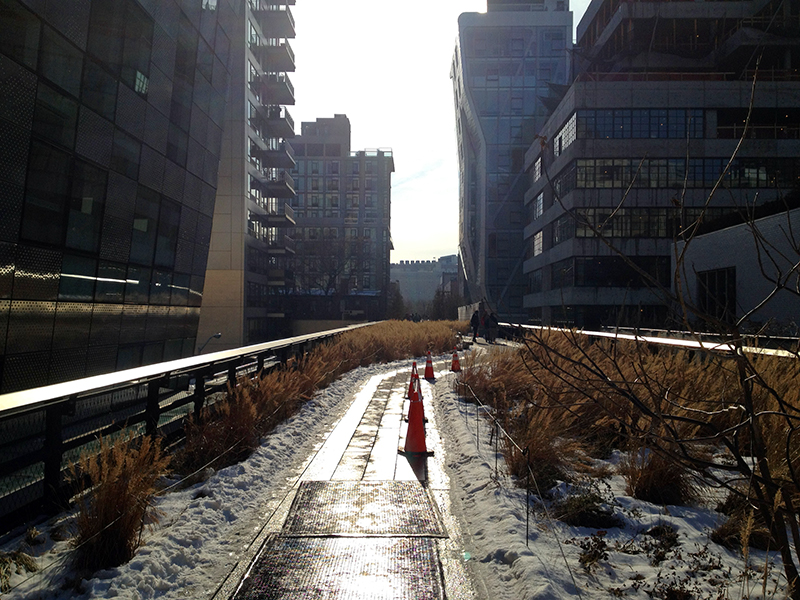
All this to say that although I’ve followed this project for years, I hadn’t actually gotten the chance to visit until last week. And I was so impressed. The hardscape materials—steel, glass and concrete—were combined with enough weathered wood to warm up the garden without losing touch with its urban environment. I loved the little alcoves that jutted off the main path. They formed garden rooms that would give a gathered group of friends a sense of intimacy while still allowing them to be part of the action.
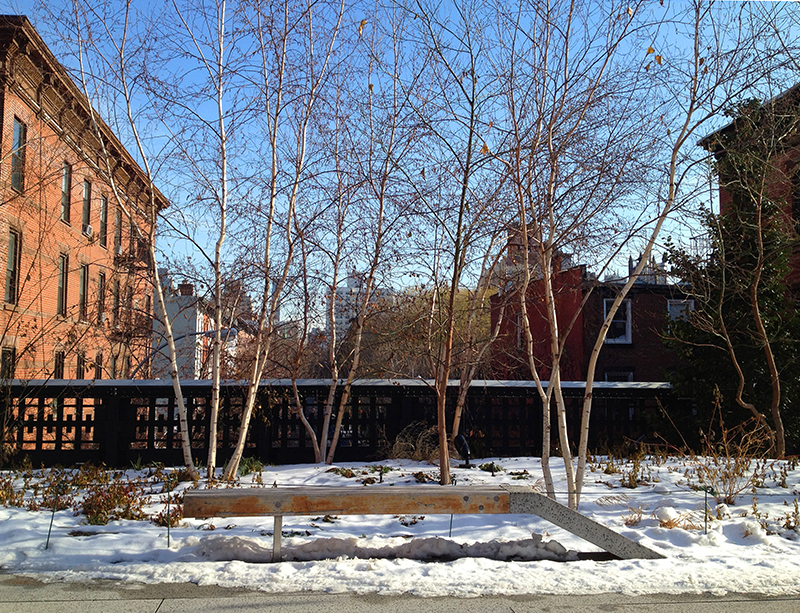
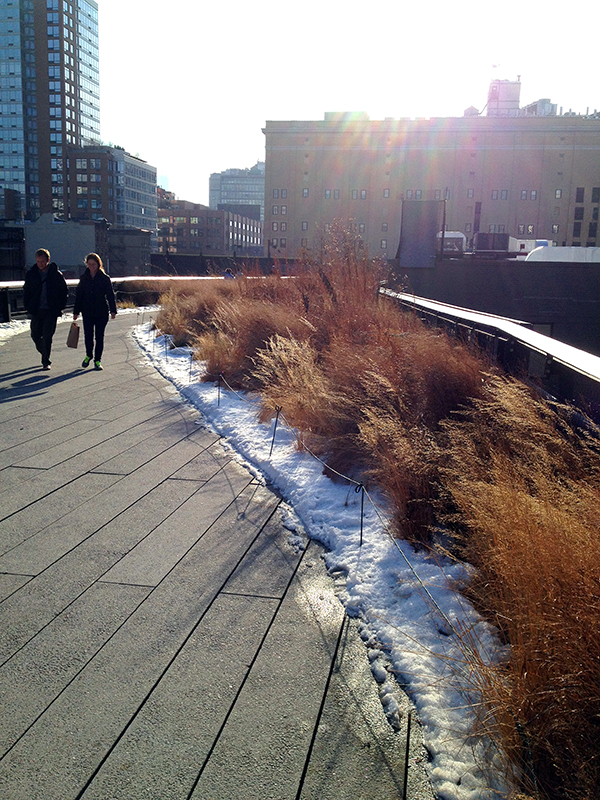
And of course, the plantings were awesome. I know enough about Oudolf’s work to expect a lot of grasses and dried seedheads this time of year, and the High Line didn’t disappoint. Oudolf designs for four-season interest, and I suspect that the dried plant material and stark, berried bushes we saw in winter might be even more interesting than the abundant but overplayed flowers of summer. A blanket of snow threw all the plants into beautiful relief and was an extra bonus.
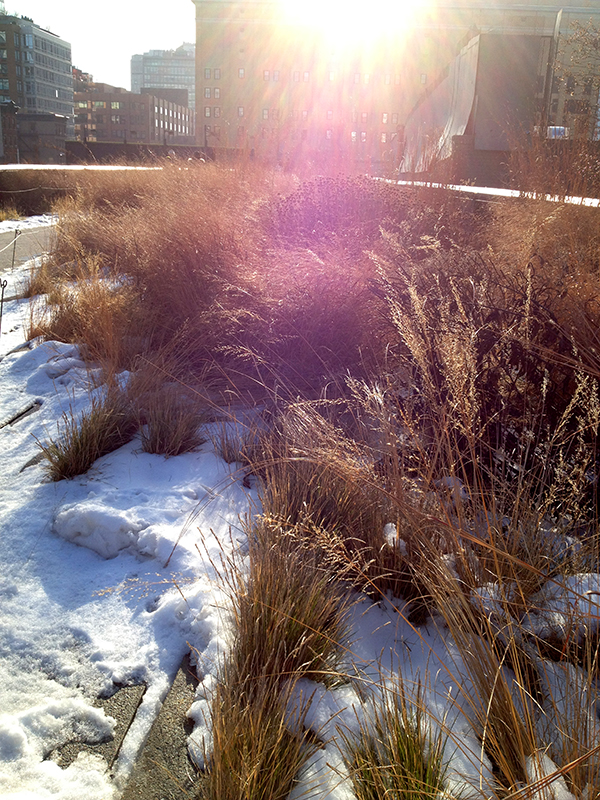
I know “naturalistic,” “new perennial,” and “meadow” planting are so trendy in garden design right now, and I also know just how much work and knowledge it takes to put together a garden design that replicates a natural meadow. But I was really struck, as I walked the High Line, by how it looked like one could have just transplanted a section of my front yard right into Manhattan. If that was Oudolf’s intention, and I believe it was, no doubt he succeeded. And maybe I succeeded too, by setting up my home in a natural, beautiful meadow without having to plant it first! Art imitates life, life is—if we keep our eyes open—art.
Bonafide Farm, February 2013
December 25th, 2013 §
Despite the roaring fire in the woodstove, Santa found his way down our chimney last night.
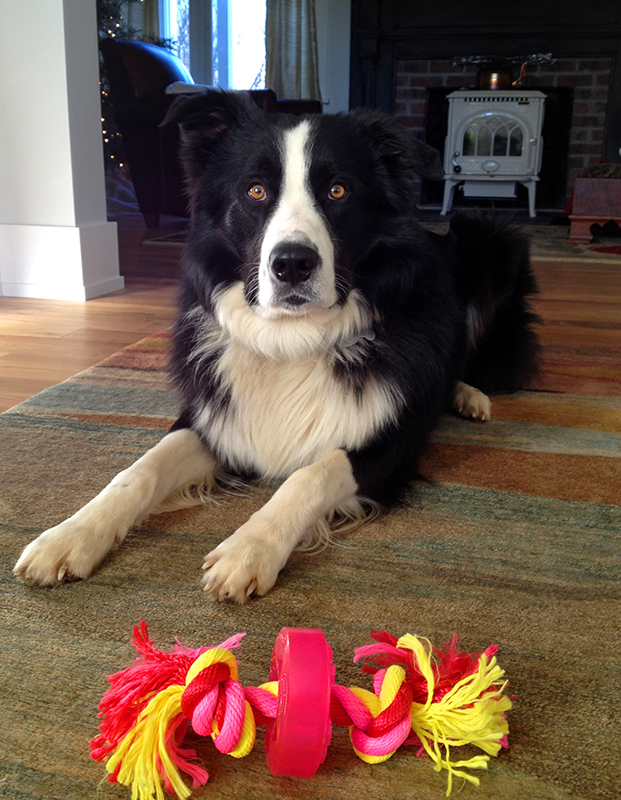
He even found the peanut butter to stick in Tucker’s present.
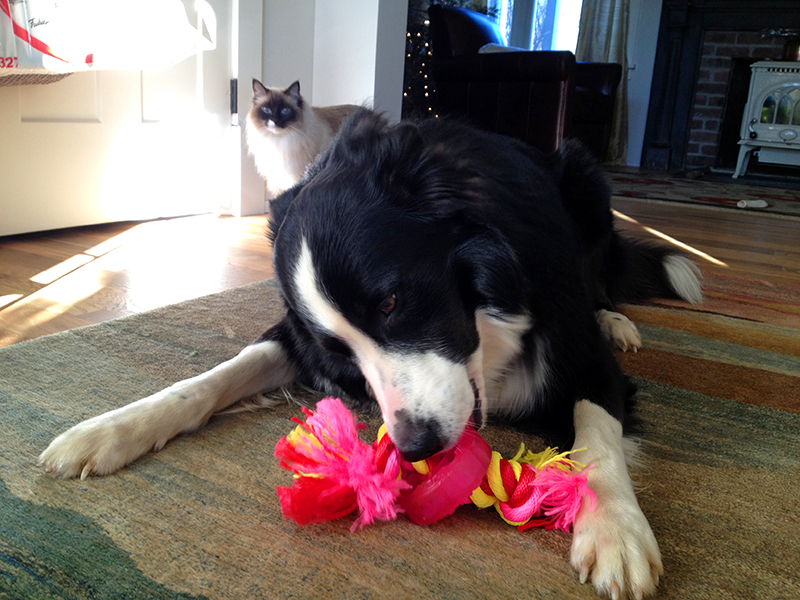
Once the peanut butter was gone, in less than five minutes, I got the new toy dumped on my lap and an invitation to play.

So much for Tucker quietly amusing himself. But at least he understands the holiday lesson of sharing.
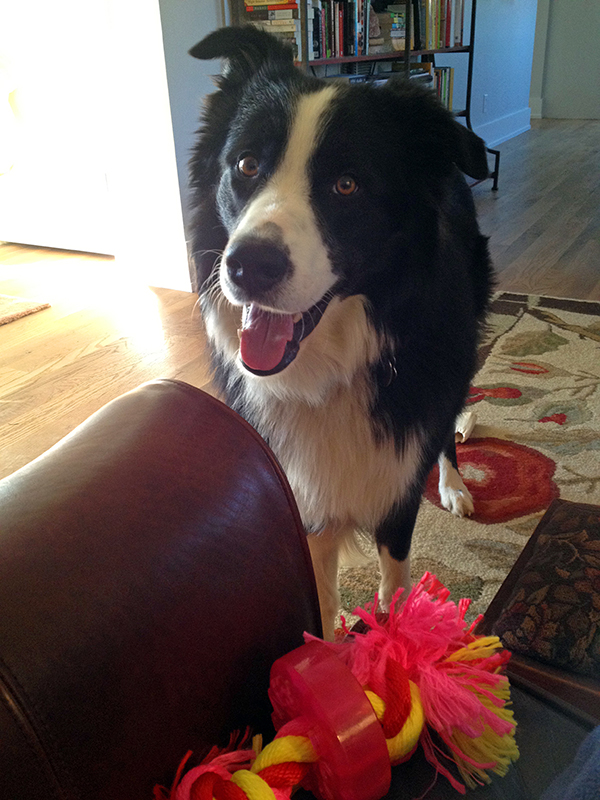
Merry Christmas from our little farm family to yours!





